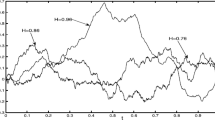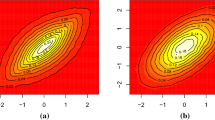Abstract
From a continuous-time long memory stochastic process, a discrete-time randomly sampled one is drawn using a renewal sampling process. We establish the existence of the spectral density of the sampled process, and we give its expression in terms of that of the initial process. We also investigate different aspects of the statistical inference on the sampled process. In particular, we obtain asymptotic results for the periodogram, the local Whittle estimator of the memory parameter and the long run variance of partial sums. We mainly focus on Gaussian continuous-time process. The challenge being that the randomly sampled process will no longer be jointly Gaussian.


Similar content being viewed by others
References
Abadir KM, Distaso W, Giraitis L (2009) Two estimators of the long-run variance: beyond short memory. J Econom 150(1):56–70
Axler S, Bourdon P, Ramey W (2000) Harmonic function theory. Graduate texts in mathematics, vol 137. Springer, New York
Bardet J-M, Bertrand P (2010) A non-parametric estimator of the spectral density of a continuous-time Gaussian process observed at random times. Scand J Stat 37(3):458–476
Beran J, Feng Y, Ghosh S, Kulik R (2013) Long-memory processes. Probabilistic properties and statistical methods. Springer, Heidelberg
Brillinger DR (1969) The calculation of cumulants via conditioning. Ann Inst Stat Math 21(1):215–218
Chambers MJ (1996) The estimation of continuous parameter long-memory time series models. Econom Theor 12(2):374–390
Comte F (1996) Simulation and estimation of long memory continuous time models. J Time Ser Anal 17(1):19–36
Dacorogna MM (2001) An introduction to high-frequency finance. Academic Press, San Diego
Dalla V, Giraitis L, Hidalgo J (2006) Consistent estimation of the memory parameter for nonlinear time series. J Time Ser Anal 27(2):211–251
Doukhan P, Oppenheim G, Taqqu M (2003) Theory and applications of long-range dependence. Birkhäuser, Boston
Giraitis L, Leipus R, Philippe A (2006) A test for stationarity versus trends and unit roots for a wide class of dependent errors. Econom Theory 22:989–1029
Giraitis L, Koul HL, Surgailis D (2012) Large sample inference for long memory processes. Imperial College Press, London
Gradshteyn IS, Ryzhik IM (2015) Table of integrals, series, and products, 8th edn. Elsevier/Academic Press, Amsterdam
Hurvich CM, Beltrão KI (1993) Asymptotics for the low-frequency ordinates of the periodogram of a long-memory time series. J Time Ser Anal 14(5):455–472
Jones RH (1985) Time series analysis with unequally spaced data. Handb Stat 5:157–177
Leonenko N, Olenko A (2013) Tauberian and Abelian theorems for long-range dependent random fields. Methodol Comput Appl Probab 15(4):715–742
Li Z (2014) Methods for irregularly sampled continuous time processes. PhD Thesis, University College of London
Philippe A, Viano M-C (2010) Random sampling of long-memory stationary processes. J Stat Plan Inference 140(5):1110–1124
Philippe A, Robet C, Viano M-C (2021) Random discretization of stationary continuous time processes. Metrika 84(3):375–400
Pólya G (1949) Remarks on characteristic functions. In: Proceedings of the first Berkeley conference on mathematical statistics and probability. pp 115–123
Thiebaut C, Roques S (2005) Time-scale and time-frequency analyses of irregularly sampled astronomical time series. EURASIP J Adv Signal Process 2005(15):852587
Tsai H, Chan KS (2005a) Maximum likelihood estimation of linear continuous time long memory processes with discrete time data. J R Stat Soc Ser B Stat Methodol 67(5):703–716
Tsai H, Chan KS (2005b) Quasi-maximum likelihood estimation for a class of continuous-time long-memory processes. J Time Ser Anal 26(5):691–713
Author information
Authors and Affiliations
Corresponding author
Additional information
Publisher's Note
Springer Nature remains neutral with regard to jurisdictional claims in published maps and institutional affiliations.
Appendix: Proof of Lemma 2
Appendix: Proof of Lemma 2
Proof
The proof is essentially based on Corollary 2 and a well known cumulant formula.
Without loss of generality, we can assume that the Poisson rate is 1. The process Y is 4th order stationary as the conditional joint distribution of \((Y_k,Y_{k+h},Y_{k+r},Y_{k+s})\) given \((T_1,\dots ,T_{k+\max (h,r,s)})\) is a multivariate normal with variance-covariance matrix \(M(T_k,T_{k+h},T_{k+r},T_{k+s})\) given by
which is k free. Hence it is enough to establish the lemma when \(k=0\). We apply the total law of cumulance formula (Brillinger 1969), which for the sake of clarity, we remind here: for all random vectors \(Z=(Z_1,\ldots ,Z_n)'\) and W, we have
where \(X_{\pi _j}=(X_i,i\in \pi _j)\), and \(\pi _1,\ldots ,\pi _b\), (\(b=1,\ldots ,n\)) are the blocks of the permutation \(\pi \), and the sum is over all permutations \(\pi \) of the set \(\{1,2,\ldots ,n\}\).
But condition on T, the process \(Y_t\) is jointly zero-mean Gaussian and therefore \(\mathbb {E}(Y_t\vert T)=0\) as well as \(\textrm{cum}(Y_i,Y_j,Y_k,Y_\ell \vert T)=\textrm{cum}(Y_i,Y_j,Y_k\vert T)=0\) for all \(i,j,k,\ell \). Hence applying (42) to \(Y_t\) with \(W=T\), only the two-by-two partitions of \(\{0,h,r,s\}\) will survive. and since \(\textrm{cum}(U,V)=\text {Cov}(U,V)\), we get from (41)
Note that for \( h< \min (r,s)\), \(\textrm{Cov}(\sigma _X(T_h),\sigma _X(T_r-T_s))=0\). Moreover
The last configuration is
Therefore uniformly in h we have
For the remaining two terms in the right hand side of (43) we have, for fixed h,
This concludes the proof of (37).
Let us now prove (38). Note that
Moreover, we have
In the particular case \(d=1/4\) (where we still have \(\alpha =2\)), a supplementary term \(\log (n)\) is needed in the bound. Indeed we split the sum in the right hand side of (44) into 3 configurations. when \(1 \le h \le r< s \le n\) the covariance \( \textrm{Cov}(\sigma _X(T_h),\sigma _X(T_r-T_s))\) is zero. When the sum is over \(1 \le r< h \le s \le n\), we get
For the last sum over \(1 \le r < s \le h \le n\) (where we will need the \(\log \) term) we have
Rights and permissions
Springer Nature or its licensor (e.g. a society or other partner) holds exclusive rights to this article under a publishing agreement with the author(s) or other rightsholder(s); author self-archiving of the accepted manuscript version of this article is solely governed by the terms of such publishing agreement and applicable law.
About this article
Cite this article
Ould Haye, M., Philippe, A. & Robet, C. Inference for continuous-time long memory randomly sampled processes. Stat Papers (2023). https://doi.org/10.1007/s00362-023-01515-z
Received:
Revised:
Published:
DOI: https://doi.org/10.1007/s00362-023-01515-z




